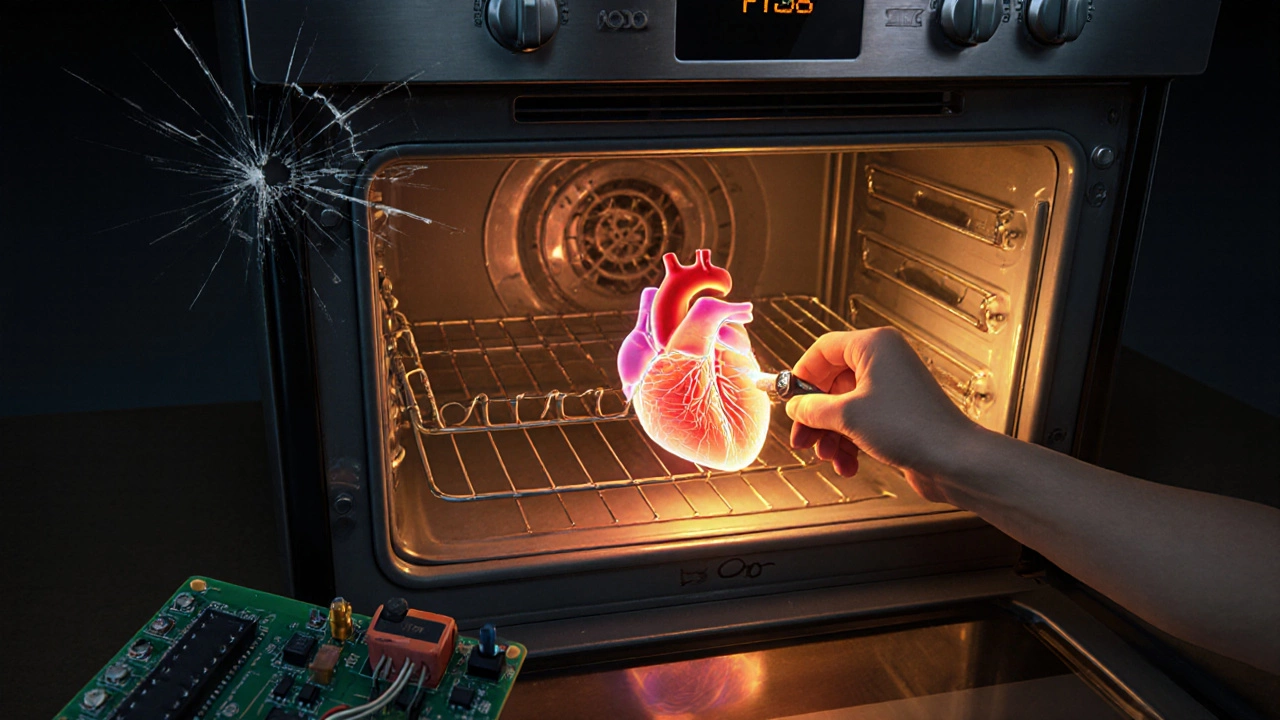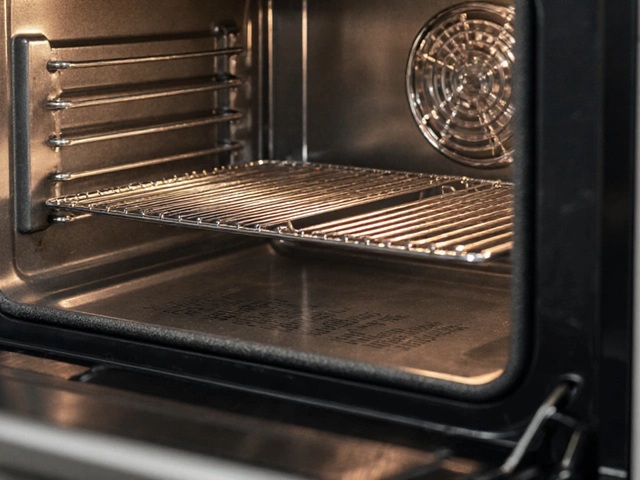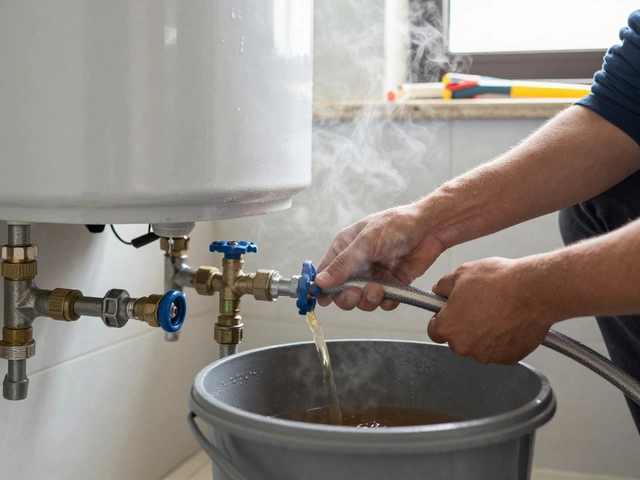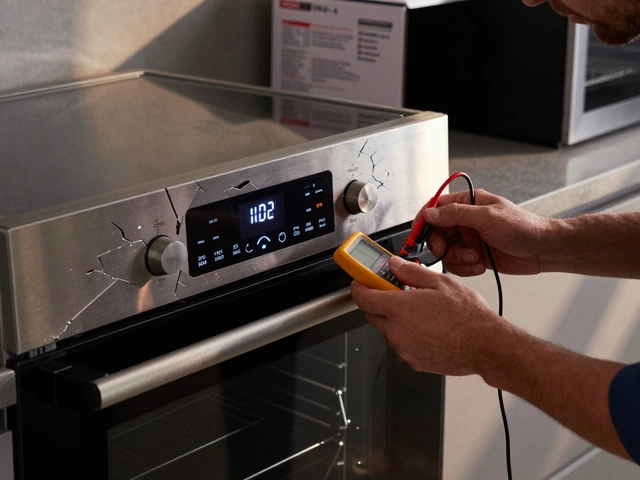If your electric oven suddenly stopped working, you’re not alone. It’s one of the most common appliance emergencies - especially when you’re mid-recipe or hosting dinner. No glowing elements, no heat, no display lights. It feels like the whole kitchen has gone dark. But before you call a technician or start shopping for a new oven, here’s what’s likely going on - and how to fix it yourself.
Check the Power First
Before you assume the oven is broken, make sure it’s getting electricity. Electric ovens need 240 volts, delivered through a dedicated circuit. Unlike your toaster or coffee maker, they don’t plug into a regular outlet. They’re hardwired or connected via a heavy-duty plug, often behind the appliance.Start by checking your home’s circuit breaker panel. Look for a double-pole breaker labeled “Oven,” “Range,” or “Cooktop.” If it’s tripped, reset it. If it trips again right away, don’t keep resetting it - that’s a sign of a serious electrical fault. You’ll need an electrician.
Some ovens have a separate internal fuse or thermal cut-off. If the oven doesn’t turn on at all - no display, no fan, no lights - and the breaker is fine, this could be the issue. Older models often have a thermal fuse near the heating element or vent. If it’s blown, the oven won’t power up. You can test it with a multimeter, but if you’re not comfortable with electrical components, skip to the next step.
The Heating Element Is the Most Common Culprit
If the oven’s display works but nothing heats up, the problem is almost always the heating element. There are two main elements: the bake element (bottom) and the broil element (top). The bake element does most of the work during regular cooking.Look inside the oven. Is the bottom element darkened, cracked, or bulging? That’s a clear sign it’s burned out. Even if it looks fine, test it. Turn off the power at the breaker, then remove the screws holding the element in place. Pull it out slightly and use a multimeter to check for continuity. If the meter reads infinite resistance (OL), the element is dead.
Replacing it is simple. New elements cost between $30 and $80 depending on your model. Unplug the old one, connect the new one the same way, screw it back in, and restore power. Most ovens don’t require special tools. Just make sure the power is off. I’ve seen people try to replace an element with the breaker still on - that’s how you get a shock and a trip to the ER.
Thermostat or Temperature Sensor Failure
Sometimes the oven turns on, but it doesn’t heat to the right temperature. It might get warm, then stop. Or it runs too hot and burns everything. That’s usually the thermostat or temperature sensor.Modern ovens use a temperature sensor - a thin metal probe usually mounted on the back wall. It tells the control board how hot it is inside. If it’s faulty, the oven thinks it’s hotter than it really is, so it shuts off early. Or it thinks it’s cold, so it keeps running.
To test it, you’ll need a multimeter. Set it to ohms (Ω). Remove the sensor (usually held by two screws), and measure resistance at room temperature. A good sensor reads between 1000 and 1100 ohms. If it’s way off - say, 500 or 2000 - it’s bad. Replacements cost $25 to $50. Install the new one the same way, and recalibrate if needed.
Older ovens with dial thermostats are trickier. They can’t be tested easily without special tools. If you’ve ruled out the element and sensor, and the oven still doesn’t heat properly, the thermostat might be the issue. In those cases, replacement is often the only fix.

Control Board or Electronic Control Failure
If the display is blank, buttons don’t respond, or the oven won’t turn on even with power at the breaker, the control board might be dead. This is the brain of the oven. It manages everything - timing, temperature, fan, lights.Control boards fail from overheating, power surges, or just age. If your oven is over 10 years old and you’ve had recent power fluctuations (like during storms), this is a likely cause. Unfortunately, you can’t test it without diagnostic tools. But here’s a trick: if the clock or timer works but the oven doesn’t heat, the control board might still be partially functional. If nothing at all works, it’s probably dead.
Replacing the control board costs between $150 and $300. It’s not a beginner job. Wires are tricky, and one wrong connection can fry the new board. If you’re not confident, hire a technician. But if you’re handy, YouTube has step-by-step videos for most models. Just make sure you get the exact part number from your oven’s serial plate.
Broken Door Switch or Latch
Many ovens won’t turn on if the door isn’t fully closed. That’s a safety feature. But the switch that detects door closure can fail. If the oven doesn’t respond when you close the door, or it shuts off randomly during use, check the door switch.It’s usually a small plastic or metal button near the door frame. Press it manually while the oven is on (power on, but don’t start a cycle). If the oven turns on when you press it, the switch is worn out. Replacements cost under $20. Unplug the oven, remove the old switch, snap in the new one, and test it.
Some models have a latch mechanism that locks the door during self-clean mode. If that latch gets stuck or the motor fails, the oven may refuse to operate at all. You’ll hear a clicking noise or see an error code like “F9” or “Door Lock.” Resetting the oven by turning off the breaker for 5 minutes can sometimes clear it. If not, the latch assembly needs replacing.

What to Do When You’re Not Sure
If you’ve checked the breaker, element, sensor, and control board - and nothing’s obvious - it’s time to pause. Don’t guess. Don’t keep replacing parts hoping one will fix it. That’s how you spend $300 and still have a broken oven.Look at the error codes. Most modern ovens display them on the screen. Codes like F1, F3, E1, or E2 mean something specific. Write down the code and search your model number + error code online. Manufacturers publish these. For example, “F3” on a Whirlpool oven usually means a faulty temperature sensor. “E1” on a GE oven often points to a control board issue.
Check the user manual. If you don’t have it, search online for “[your brand] [model number] manual PDF.” Most are available for free. They list error codes and troubleshooting steps.
And if you’re still stuck? Call a technician. But ask them this: “Can you diagnose it over the phone first?” Many repair services will ask you to check a few things before showing up. That saves you a service call fee if it’s something simple.
When to Replace Instead of Repair
Not every broken oven is worth fixing. Here’s when to walk away:- Your oven is over 15 years old - parts are scarce, efficiency is low, and repair costs often exceed 50% of a new unit’s price.
- You need two or more major parts replaced - element, sensor, and control board - that’s usually more than $400. A new mid-range oven starts at $500.
- The oven has recurring issues. If it’s broken again six months after a repair, it’s a sign of deeper problems.
- You’re upgrading your kitchen anyway. It’s a good time to get a modern oven with convection, smart features, or better energy ratings.
But if your oven is under 10 years old and only one part is bad - like the heating element - fix it. Most repairs cost under $100 and last another 5-10 years.
Prevent Future Problems
Once your oven’s working again, avoid repeating this. Here’s how:- Don’t use the self-clean function more than once a year. It stresses the elements and sensors.
- Keep the oven clean. Built-up grease can cause overheating and sensor errors.
- Use surge protectors for hardwired appliances. Power spikes from storms or grid issues can kill control boards.
- Check the oven’s ventilation. Blocked vents cause overheating, which kills electronics faster.
- Replace worn door seals. A leaky door makes the oven work harder, straining the heating system.
Electric ovens are built to last. But like any machine, they need a little care. Most sudden failures aren’t mysterious - they’re predictable. And most of the time, you can fix them yourself.
Why is my electric oven not heating but the light works?
If the oven light works but nothing heats up, the issue is almost always the bake or broil heating element. The light runs on a separate 120-volt circuit, while the heating elements need 240 volts. A failed element won’t affect the light. Check for visible damage or test it with a multimeter. Replacing it is usually simple and inexpensive.
Can a blown fuse cause my electric oven to stop working?
Yes. Some electric ovens have an internal thermal fuse that cuts power if the oven overheats. If this fuse blows - often due to a blocked vent or failed element - the oven won’t turn on at all. You can test it with a multimeter. If it shows no continuity, replace it. Fuses cost under $15 and are easy to swap. But if it blows again, you have a deeper problem like a faulty element or thermostat.
Why does my oven turn off after a few minutes?
This usually means the temperature sensor is faulty. It sends the wrong signal to the control board, making it think the oven is hotter than it is. The oven shuts off to prevent overheating. Test the sensor’s resistance with a multimeter - it should read around 1000-1100 ohms at room temperature. If it’s off by more than 100 ohms, replace it. Dirty sensors can also cause this, so clean the probe gently with vinegar before testing.
Is it safe to use my oven if the glass door is cracked?
No. A cracked door compromises heat retention and safety. It can cause the oven to overheat externally, damage nearby cabinets, or even shatter under high heat. The door seal also fails, making the oven work harder and increasing energy use. Replace the door assembly immediately. Don’t risk fire or burns. Most manufacturers sell replacement door glass or full assemblies for under $100.
What should I do if my oven displays an error code?
Write down the exact code - like F2, E1, or C2 - and search your oven’s brand and model number with the code online. Most manufacturers list error code meanings in their service manuals. Common codes: F3 means temperature sensor failure, F1 means control board error, E2 often means door lock issue. Don’t guess. Use the code to pinpoint the problem before buying parts.









